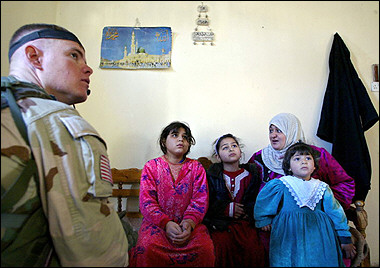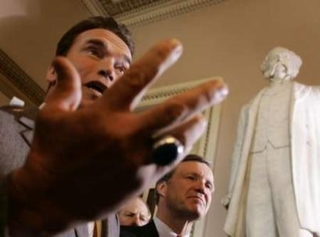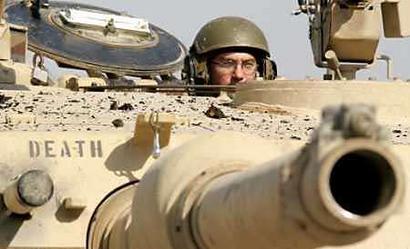Notes
Following Through With The Engagement

One of the best photo sites dealing with the war is called Iraq Uncensored (link).
This shot was taken by Kael Alford, one of the few non-embedded photographers in Baghdad at the beginning of the conflict. Last year, she was in Najaf documenting the confrontation between the U.S. and the Mehdi army. Among the photos she took, a number capture interesting glimpses of Iraqi women.
Earlier this week, Amnesty International issued a report on the status of women in Iraq. A conclusion of the document is that, since the overthrow of Saddam, conditions for Iraqi women have actually gotten worse, not better. In the chaos that has ensued, AI reports that women are more at risk for physical and sexual violence. Also, the higher level of rights long enjoyed by Iraqi women, as compared to most in the Arab world, is apparently breaking down. Most worrisome is the fact this slide has occurred under the coalition watch. Far from enjoying greater protection under American troops, however, there have even been reports of abuse perpetrated by our own side.
If you’re one to take spin at face value, you could easily become lightheaded over prospects for Iraq. The post-election, behind-the-scenes power struggle is being touted as nothing beyond democratic. Also, a flood of optimistic words are pouring forth about the impending Iraqi constitution — the next step in the heralded march to freedom. As President Bush cavorts around Europe talking up human right, however (and Condi Rice follows close behind in dominatrix-inspired attire, soaking up attention in what the WAPO describes as a female display of power and sexuality), I wonder how much capital the Administration is really willing to spend to enshrine Iraq women with the same freedoms they had before we so benevolently liberated them.
If you’ve been following the BAG, you know I’ve been regularly tracking newswire images from Mosul, using them as a prism through which to examine domestic, day-to-day aspects of America’s intervention. According to the caption, this shot (published Tuesday) shows an Iraqi mother answering questions posed by US soldiers during a Mosul patrol.

As a small point, I have to complain about this caption. I can’t say what is going on, but it doesn’t look like the American and this Iraqi woman are having any interaction at all. Rather, it seems like the soldier and the family are watching television, probably while other soldiers search the house. My larger point, though, is to emphasize how much the women of Iraq are dependent on the care and custody of men — American or otherwise.
While this picture seems straightforward, Ms. Alford’s photo suggests that the status of women in an occupied, and morally shifting Iraqi society, is far more precarious. (Click here for a larger version.)
Notice the only hidden face in the image belongs to the bride. In the window (of the bridal shop?) however, is the painted image of a woman who also seems like a bride. In contrast to the hidden wife-to-be, the painted version offers a seductive look. Seeming to touch the head of the veiled bride is a painted pack of cigarettes.
One reading here is that the painted image is the bride’s alter-ego. Like a thought bubble, the painted image suggests the real bride is thinking about consummating her marriage, with the cigarette waiting as a reward. And if such an interpretation turned out to be wildly inaccurate, well… it’s not hard to imagine the man in the street, the American soldier, or even the fiance fantasizing it that way. Mixed messages can also be attributed to the partially veiled woman directly to the right of the bride. Looking directly at the viewer, and flanking the real bride in alignment with the painted one, her gaze could be seen as forward, as well.
Going back to the Amnesty International report, and the responsibility of the United States for owning what we’ve broken, the women of Iraqi deserve more than just good words. Especially when, in interpreting the gaze, it will mostly be men who will debate whether these women are looking with recognition, looking for recognition, or looking for trouble.
(image 1: Kael Alford, Iraqi Uncensored; image 2: AFP/Mauricio Lima in Yahoo News)


Reactions
Comments Powered by Disqus